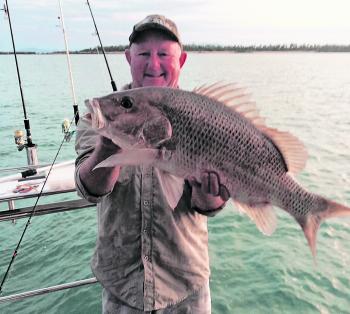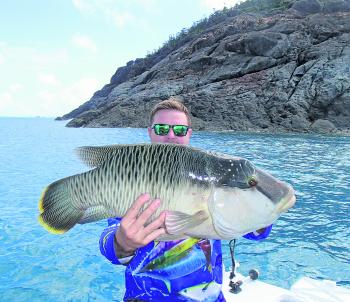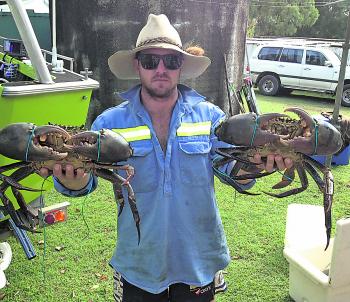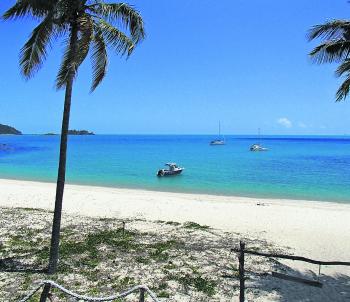With more and more people coming into the shop to ask about Stanage Bay, I thought it was time for an in depth look.
Stanage Bay is located between Rockhampton and Mackay. The only access in is via 100km of dirt road. The road isn’t too bad at the moment, but always be prepared as it can be pretty rough. Due to the amount of trips a year I do up there, I’ve had a nylon cover made for both of my boats to prevent stone damage to the hull. Just take your time and everything should be fine.
Stanage would have to be one of my favourite spots on the east coast. My family has had a house up there since well before my time, so most of my childhood holidays were spent up there. Hopefully my children will have the same memories. Stanage Bay’s remoteness, ruggedness and proximity to places like the Percy islands and Shoalwater Bay make it the perfect fishing destination in my eyes.
Whether it be flicking for barra and golden snapper up the Sound, jigging for nannygai, roughing it down at Shoalwater for a few nights or taking the family over to the beautiful Percy islands, there’s always something to do.
Now don’t get me wrong, it’s not all rosey up there. I get plenty of people come in and say, “Mate, you gave me a bum steer – there’s no fish up there.” It’s the kind of place that takes time and patience. It’s more tide and moon reliant then any place I’ve ever fished. There can be plenty of long hard days spent on the water with not much action. Once you have a few of these days (a lot in my case) you soon begin to develop patterns and know what times fish well, what species to target and what part of year will best suit you up there.
Right now is the perfect time to get up there and chase the famous Stanage Bay black jew. Black jew school up in the Sound in the warmer months and can be extremely fun on reasonably light gear, if you can get a few around the boat.
The ‘Jew Hole’ is not hard to find on the neap tides. Just look for the congregation of boats not too far from the boat ramp. There are plenty of other spots you can catch these brutes if crowds aren’t your thing. Look for any deep water with structure near the Sound. I know of three more holes that get fished nowhere near as much. In saying that, if they’re on at the one closest to the boat ramp, there’s no real need to travel any further.
For my ‘reasonably light gear’, I use 5000 size reels and 30lb braid. Any smaller and I think you would be doing extremely well. The reason I like to use such light gear in comparison to the traditional handline that 90% of people will generally use when targeting black jew up there is I like to release my fish. With the long slow fight on light gear, they have a much better release rate than when there reefed from the bottom as quick as possible with a handline. If you’re chasing a feed, go the handline. If you’re after some serious fun, go as light as possible!
Squid seems to be the standout bait. If the fish are hungry, pilchard or mullet fillets will do the job. Have a chat to the locals to find out when and where the fish are feeding. They’re are normally more than happy to help, providing you don’t go overboard and keep just enough for a feed.
There are plenty of options if the winds are blowing and offshore isn’t your thing. Around the western side of Long Island and the tip of Long Island hold good numbers of golden snapper. Try any deep water around headlands and rocks. During the open barra season, these areas also hold good numbers of barra. On the mainland side I find the last few creeks before you go around the corner into Broad Sound to be the most productive and consistent creeks. They seem to hold better numbers of threadies and have a little more structure than the creeks back towards Stanage itself.
Schools of golden snapper and grunter will generally hold in the deeper holes while any snag is worth having a throw at for barra. The introduction of side scan sounders has eliminated a lot of the guess work when it comes to working these snags. For those without the luxury of a side scan unit, this area is your best bet.
Offshore the options are endless. Whether it be soaking a bait, jigging, popping, stickbaiting or trolling for XOS Spanish, there’s always something to keep you busy. I try to keep away from the closer locations such as the Marbles and the closure shoals, as they are the most pressured. In saying that, many quality fish are still produced in close.
In the winter months I tend to head down towards Townshend Island and out towards Highpeak Island chasing largemouth nannygai. Be sure to always have your sounder reading. There is so much country down that way that you will be sure to run over something on the way. Look for the more isolated reefs and bommies to find the larger and better numbers of fish. The last of the run-out seems to be the most productive time down that way.
If reef fishing is your thing, try to base you trip around the neap tides. I normally do a few hours either side of the last quarter. If I happen to be up there on larger tides I stick to popping and stickbaiting pressure points for GTs, Spanish, queenies, trout and whatever other fish take to the lure.
On a recent trip when the tides were building we spent a day stickbaiting shallow reefs around Steep Island to Highpeak Island. This was one of the most enjoyable sessions I can remember. Trout was the main species we caught with some cracking fish up to 5kg coming over the side. There were cod, GTs, lipper, mackerel, tuna and plenty of pesky long tom. The action was non-stop at every island or rock we stopped at. The standout lures were Westin Swims, Maria Loadeds and Nomad Madscads.
This place is something else. It has massive creeks, massive tides, massive crabs and massive fish. Everything here is done to the extreme! Shoalwater Bay is closed for a good part of the year due to military exercise. With its distance from civilisation and the fact it’s closed to commercial netting, and the only access is via boat, Shoalwater Bay is virtually untouched for most of the year.
There aren’t too many places you can set your pots and within 500m of the pots be catching sweetlip and coral trout. I like to base myself in the aptly named Strong Tide Passage for this exact reason. Strong Tide Passage is the body of water that runs between the mainland and Townshend Island. It’s fringed with rocky headlands, sandy bays and mangrove creeks. Just about every type of fishing can be done in this passage when the tides allow. Jigging for trout and lipper, rolling plastics for golden snapper and grunter, throwing poppers and stickbaits for GTs and queenfish or throwing micro poppers for whiting, it can all be done within Strong Tide Passage.
Try working the top and bottom of the tide, as there can be up to 10 knots of run through the passage. If not, get in behind one of the rocks or eddies and through plastics and stickbaits up onto the shallow reef. The rock right in the middle of the mouth of Strong Tide has produced some of the biggest bar cheek trout I have caught. There’s generally a few golden snapper floating around this area as well.
Shoalwater is a big place. Some of the creeks we fish can be up to a 15 mile run from our anchorage in Strong Tide, so be sure to take plenty of extra fuel. The creeks are deep, wide and run like hell, but they are loaded with some of the best estuary fish one could imagine. Rock bars, holes and snags all produce different fish. Rock bars and holes will normally hold good numbers of golden snapper and black jew on in the eastern creeks. Weirdly, on the western side, the same type of structure will hold big grunter.
I’ve found the western creeks and the deeper water into Shoalwater hold better numbers and bigger threadies while most of the creeks have good numbers of barra. Some of the deeper creeks like Keiver Creek and East Creek will even hold good numbers of legal sweetlip and nannygai. It hasn’t been uncommon to catch golden snapper and threadfin along with the odd largemouth nannygai and grassy sweetlip. I’ve even managed to pull a few trout from the rock bar in Keiver Creek.
Crabs are generally pretty easy to come by. The biggest crabs are in Keiver, Mistake, East and any of the gutters in between. They’re not the thickest, but if you do get one it’s the size of two normal ones anyway. The small gutters along Strong Tide Passage generally produce good numbers but not nearly as big as the creeks mentioned earlier. It is also a little harder to get around, ,as all the creeks have big mud flats at the mouth. You pretty much need to be heading to your pots right at the top of the tide.
For any information on Stanage, don’t be afraid to give us a call at the shop or give Bevan and Marree Haynes a call at Plumtree Store. They also look after a fair share of the accommodation up there with options for just about any size groups.
Reads: 20320
Les Jones with a solid golden snapper from Shoalwater Bay. This fish was taken on a slow fall micro-jig worked over some deeper structure in Keiver Creek.

This beautiful wrasse was taken on a Yakamito Rager jig at Middle Percy Island.

This healthy little saltwater barra is from one of the many creeks throughout Thirsty Sound.

Jenna Gibbs-Jones with a nice redthroat emperor from High Peak Island.

Karl Hunter with a pair of 3kg Shoalwater Bay mud crabs.

Hayley Jones with a solid Stanage muddy.

The view from the famous ‘A Frame’ on Middle Percy Island.




